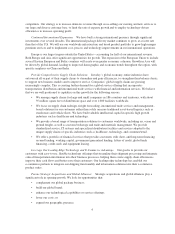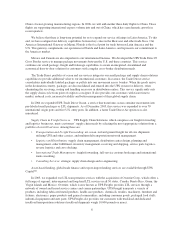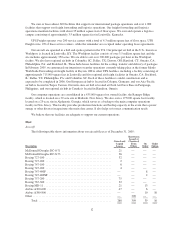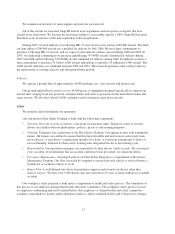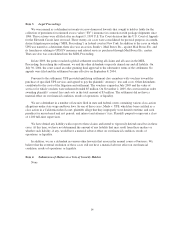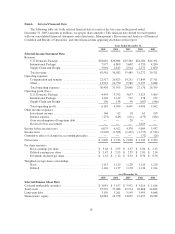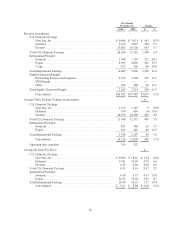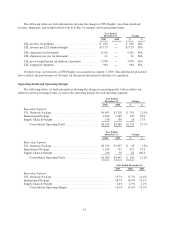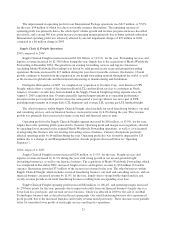UPS 2005 Annual Report Download - page 28
Download and view the complete annual report
Please find page 28 of the 2005 UPS annual report below. You can navigate through the pages in the report by either clicking on the pages listed below, or by using the keyword search tool below to find specific information within the annual report.We maintain an inventory of spare engines and parts for each aircraft.
All of the aircraft we own meet Stage III federal noise regulations and can operate at airports that have
aircraft noise restrictions. We became the first major airline to successfully operate a 100% Stage III fleet more
than three years in advance of the date required by federal regulations.
During 2005, we took delivery of six Boeing MD-11 aircraft and seven Airbus A300-600 aircraft. The final
six firm Airbus A300-600 aircraft are scheduled for delivery by July 2006. We have firm commitments to
purchase 13 Boeing MD-11 aircraft, and we expect to take delivery of these aircraft during 2006 and 2007. In
2005, we made firm commitments to purchase eight Boeing 747-400F aircraft scheduled for delivery during
2007 and 2008, and two Boeing 747-400SF aircraft scheduled for delivery during 2008. In addition, we have a
firm commitment to purchase 10 Airbus A380 aircraft and options to purchase 10 additional A380 aircraft. The
A380 aircraft deliveries are scheduled between 2009 and 2012. These aircraft purchase orders will provide for
the replacement of existing capacity and anticipated future growth.
Vehicles
We operate a ground fleet of approximately 98,000 package cars, vans, tractors and motorcycles.
Our ground support fleet consists of over 26,000 pieces of equipment designed specifically to support our
aircraft fleet, ranging from non-powered container dollies and racks to powered aircraft main deck loaders and
cargo tractors. We also have about 41,000 containers used to transport cargo in our aircraft.
Safety
We promote safety throughout our operations.
Our Automotive Fleet Safety Program is built with the following components:
•Selection. Five out of every six drivers come from our part-time ranks. Therefore, many of our new
drivers are familiar with our philosophies, policies, practices and training programs.
•Training. Training is the cornerstone of our Fleet Safety Program. Our approach starts with training the
trainer. All trainers are certified to ensure that they have the skills and motivation to effectively train
novice drivers. A new driver’s employment includes five hours of classroom training and 15 hours of
on-road training, followed by three safety training rides integrated into his or her training cycle.
•Responsibility. Our operations managers are responsible for their drivers’ safety records. We investigate
every accident. If we determine that an accident could have been prevented, we retrain the driver.
•Preventive Maintenance. An integral part of our Fleet Safety Program is a comprehensive Preventive
Maintenance Program. Our fleet is tracked by computer to ensure that each vehicle is serviced before a
breakdown or accident is likely to occur.
•Honor Plan. A well-defined safe driver honor plan recognizes and rewards our drivers when they
achieve success. We have over 3,600 drivers who have driven for 25 years or more without an avoidable
accident.
Our workplace safety program is built upon a comprehensive health and safety process. The foundation of
this process is our employee-management health and safety committees. The workplace safety process focuses
on employee conditioning and safety-related habits. Our employee co-chaired health and safety committees
complete comprehensive facility audits and injury analyses, and recommend facility and work process changes.
13



